#Semiaquatic Dinosaurs
Text

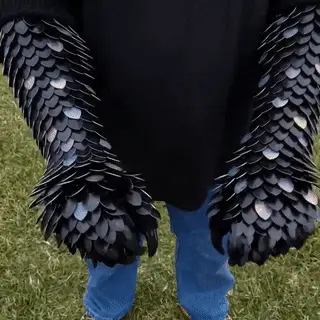

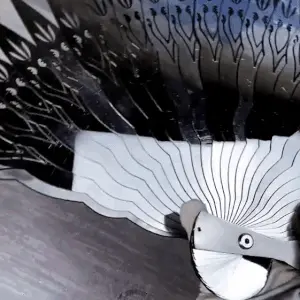

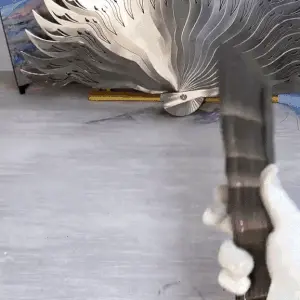
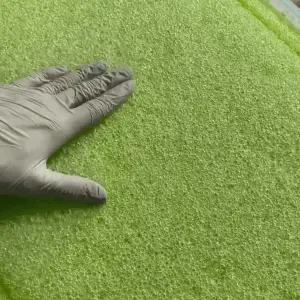
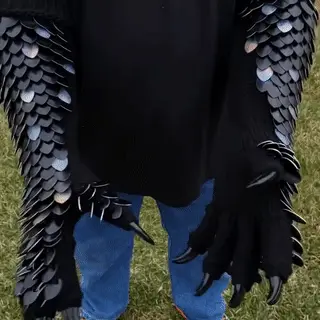
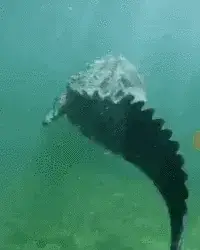
🦖•» Spinosaurus stimboard for @garagegalaxy
🏞️-🏞️-🏞️-🏞️-🏞️-🏞️-🏞️-🏞️-🏞️
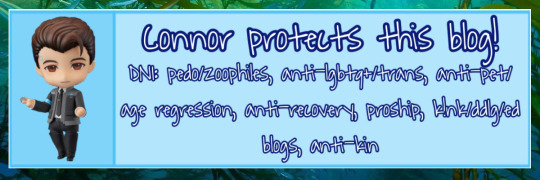
#🌊welcome diver!#finished request#requests#nonhuman#otherkin#aquatic kin#Semiaquatic kin#spinosaurus#spinosaurus kin#Dino kin#dinosaur#dinosaur kin#stimboard#dino stimboard#Spinosaurus stimboard#Dinosaur stimboard#green stimboard#black stimboard#stimboard requests
14 notes
·
View notes
Text
Here is a little friend I made in conjunction with my username; Beanoptodon! Meaning bean eye teeth, they have very big eyes, and lots of small teeth to hunt small fish and bugs out of the ponds and swamps where it resided. An intermediate species between spinosauridae and dromeosauridae, it is very light-footed, but semi-aquatic. Using its sailed tail for propulsion, it wades in shallow still waters in search of small water bugs and baby fish. The whiskers all over its body are sensory feathers, and exist over all parts of the body. The streamlined and flatter feathers are more built for swimming and keeping water off of the non-scaly skin than for steering during quick bouts of running, making it somewhat clumsy when it comes to turning while running or chasing. The feathers on top are for attracting mates and can be laid flat for camouflage or puffed up to make it seem larger than it is, and to confuse bigger hunters. Its small size (60cm long and 30cm tall) is where the prefix Bean came from. Totally.

#fake dinosaur#theropod#feathered dinosaurs#semiaquatic#namesake origin#friend shaped#fictional dinosaur#scrungly
1 note
·
View note
Text
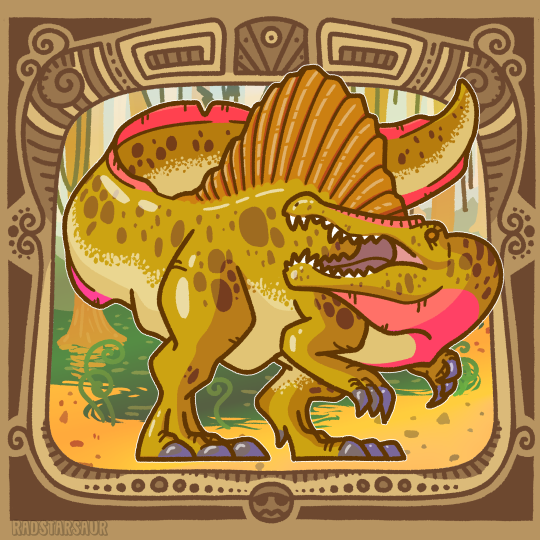
My favorite dinosaur genus of all time! Spinosaurus ("Spine Lizard") was a genus of dinosaurs that fed on fish. While believed to be semiaquatic, these dinos are notorious for the heavy debate surrounding how exactly they moved, and what the purpose of the sail-like spine was.
This piece is especially important to me due to my personal art history. I fell off of drawing for a long while, but the birth of my daughter helped get me back into it. This lost time meant that I frequently would look at the work other artists were doing online, and feel upset at myself for how far behind I was. Even when I was happy with a piece, I would immediately begin to dislike it as soon as I saw anybody else post some art. This past year, however, I've found myself finally start to feel confident in my abilities as an artist. This piece is a milestone for me, because I draw Spinosaurus frequently enough that I can actually look at past drawings and see the growth I've made as an artist. I still have a lot of growing to do, but it feels nice to look backwards and see how much of the road is behind me.

#dinosaur#dinosaur art#dinosaurs#digital art#digital illustration#clip studio art#my art#paleoart#mesozoic#cretaceous period#fossils#paleontology#paleo art#spinosaurus#spinosauridae#theropod#egypt#art growth
469 notes
·
View notes
Text

What if centaurs...but dinosaurs...
WIP for a dnd adjacent worldbuilding project. Saurids are one of the races unique to my homebrew setting and are similar to centaurs but with lower halves more akin to dinosaurs than horses.
This guy is a spinid, a semiaquatic subrace roughly inspired by Spinosaurus.
#original art#my art#illustration#dnd art#character design#dnd homebrew#creature design#concept art#rpg art#worldbuilding
21 notes
·
View notes
Text
The Sky's the Limit: Wyverns of Chortis

On Chortis, there are six groups of what we would call wyverns, which are a polyphyletic assemblage of various sarcopterygians.
Due to the high energy demands of flight, most wyverns are carnivorous (when they do eat plants, it is usually fruit). The exception is the elephant wyverns, which are flightless herbivores.
The following groups are listed in the order they were drawn:
• The first group of wyverns are the elephant wyverns (Clade Pachydermoptera), named due to their prehensile trunks and generally large size. This group includes the heaviest wyvern that ever lived, containing herbivorous and omnivorous taxa. They are also the smallest group of wyverns. When they were first discovered by European settlers that entered the magic portals, they were thought to be a type of monotreme. Then, analysis of their morphology showed that they were an aberrant clade of trionychian turtles (yes, you read that correctly).
The ancestral shell has atrophied, being reduced to rib-like components. Despite their forelimbs resembling wings, they did not evolve from flying animals, rather their ancestor possessed wing-like flippers. They physically can't fly due to their wings being too dense and the fact that they lack the adaptations seen in flying vertebrates. Nowadays, extant taxa use them for balance, intimidation, display, swimming, or quadrupedal locomotion.
• The second are the more common saurian wyverns (Clade Vernosauria), a group of primarily carnivorous winged saurischian dinosaurs that can be divided into quadrupedal and bipedal taxa. They were formerly thought to be closely related to the ichthyosaur-like dyptosaurs but they are now believed to be descended from a Pampadromaeus-like taxon, making them a bit closer to true sauropods. This group includes the highest number of wyvern species. Interestingly, most saurian wyverns are venomous. They may or may not have proto-feathers, depending on the vernosaur family.
• Then there are the bird wyverns (Clade Coccatraciformes (And yes I'm using Monster Hunter terminology) which aren't birds in the strict sense but an offshoot of the scansoriopterygids. Like the Yi+Ambopteryx clade and unlike the majority of maniraptorans, they have bat-like membranous wings supported by 3 digits and a styliform wristbone. Unlike their predecessors, many bird wyverns can fly. They are split into two groups, the Aviteratosauria (bird monster lizards), which are more reptilian in their physiology and then there are the Paratornithes, which are more bird-like in their physiology.
•Vintage wyverns (Clade Opisthoptera), named such due to their resemblance to Terran heraldic wyverns, are a clade of winged archosauromorphs descended from a member of the Sharovipteryx+Ozimek clade. Most vintage wyverns are raptorial predators, though waders, skimmers, scavengers, ovivores, and granivores are present. Unlike most wyverns, they possess wings derives from their hindlimbs, being sharovipterygians.
• The frog wyverns, also known as elf wyverns (Clade Elfinoptera) are a clade of volant temnospondyls nested in the Dissorophoidea, making them a sister group to Lissamphibia, which includes actual frogs. They are heterothermic, with their metabolism changing depending on factors such as their environment and the availability of food and water. The "elf" part is in part due to the ear-like protrusions of the lower jaw.
Many but not all taxa have a ballistic tongue, which aids in feeding.
• The last and oldest group, the piscine wyverns (clade Volanichthyes, more MH terminology for you). Strangely, unlike most wyverns, piscine wyverns are not tetrapods, let alone tetrapodomorphs. Instead, they are closely related to lungfish (being dipnomorphs, specifically porolepiforms) yet have converged with early tetrapods. While adults are terrestrial or semiaquatic, all volanichthyans (with the exception of mouthbrooders) must return to water to lay their eggs.
Based on an interpretation of the ocean flish by Fabio Alejandro/Dragonthunders as a different clade of lobe-finned fish. Subsequent piscine wyvern designs will be more "fishy", since this is just a generic example and not representative of any species native to Chortis (also too similar to tetrapods design-wise).
Extra notes: Saurian wyverns were the first type planned (since 2021), going through many phases, they were originally going to be an offshoot of varanoid lizards, then a clade of archosaurs endemic to an alternate Earth (before the idea for an exoplanet was thought of), then basal diapsids descended from araeoscelidids, then compsognathiforms (Compsognathidae is probably polyphyletic so it was changed to stem-tetrapods). Now, they are sauropodomorphs.
#chortis: territory of magic#speculative biology#worldbuilding#creature design#dragon#speculative evolution
11 notes
·
View notes
Text
Spectember D3: Atavism
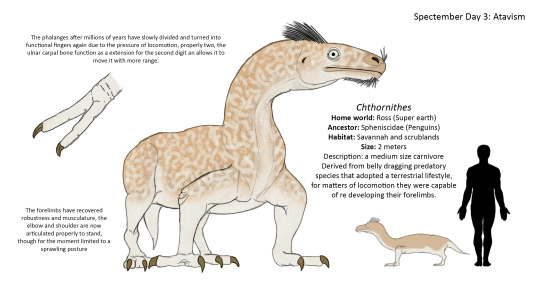
The colony planet "Ross" was a very cold super earth when humans arrived, served as a early settlement for the human interstellar expansion and then as a sanctuary of earth fauna when this was facing an ecological crisis, Ross was populated by different species of penguins that thrived on the conditions, so well that when humans finally disappeared, they kept evolving. Dozens of millions of years the semiaquatic birds managed to conquer the land, establishing as the dominant terrestrial tetrapods, as this world started to get warmer and warmer, and it was until 100 million years something more peculiar happened, something brough back of the ancestry of birds much far behind of dinosaurs, when their ancestors were just semi erect archosauromorphs.
The Chthornithes is sort of return of the “reptilian” condition, resemble little of the semi aquatic creatures that came from, its result of the dry warm climate that have slowly changed its metabolism to an ectotherm, this is a descendant of a branch of belly dragging terrestrial carnivores that properly modified its wings into functional arms, with didactyl and clawed digits that were slowly reforming as they needed proper ways to grasp on the ground, useful for movement now as it can stand on its forelimbs, the skin is covered predominantly of scales, with partial filament like feathers at the top of its neck and head which are remains of their far ancestral feathered forms. These minuscule pebble-like scales, even though looks similar to the earth squamates, aren’t originated similar but derived from feathers adopting something like the feet scales. The head is shaped differently, the beak has shortened, now the lacrimal extend further and leaves the nasal cavity in front making some resemblance to the head of an early theropod, with some rudimentary long blade shaped teeth that allows it to eat small invertebrates and small bird species.
This animal inhabits the large landmass of Ross that formed over the last 50 million years in the equatorial regions, especially in the savannah and scrublands, alongside other peculiar forms of penguin descendants that resemble still birds in many degrees this bizarre animal is a newcomer that could eventually change the landscape of this super earth from bird shaped dominant megafauna to something totally different, if it is capable to survive and leave descendance.
Derived from belly dragging predatory species that adopted a terrestrial lifestyle, for matters of locomotion they were capable of redeveloping their forelimbs, as well for the climate and metabolism have lost most of its feathers that have turned into scales.
The phalanges after millions of years have slowly divided and developed again functional fingers again due to the pressure of locomotion, properly only two with the second using the ulnar carpal bone as a extension for the second digit that allows it to move it with more range. The forelimbs have recovered robustness and musculature, the elbow and shoulder are now articulated properly to stand, though for the moment limited to a semi-sprawled posture.
---------------------------------
This is sort of a old continuation of a piece I made years ago about a terraformed sanctuary world with penguins which it continues the peculiar adaptation these had without any competition apart of themselves

#speculative evolution#future evolution#seed world#terraformed world#penguin#quadrupedal bird#spectember
93 notes
·
View notes
Text
Daurlong vs Natovenator


Factfiles:
Daurlong wangi

Artwork by @i-draws-dinosaurs, written by @i-draws-dinosaurs
Meaning: Wang’s Daur dragon (named for the Daur people of Northeast China)
Time: 121 million years ago (Aptian stage of the Early Cretaceous)
Location: Longjiang Formation, Inner Mongolia, China
Daurlong was described in 2022, from a stunningly beautiful fossil that includes the entire body, crushed flat by pressure, and a whole lot of soft tissues like feathers along the back of the neck and even the shape of the intestines! Any part of the digestive system is extremely rare to find in fossils, so Daurlong provides an important glimpse into how the digestive systems of birdlike dinosaurs compare to living dinosaurs today!
Turns out, despite being closely related to the ancestors of modern birds Daurlong’s guts were pretty similar to other, much more distant theropods like Scipionyx instead. That helps fill in a pretty big gap in our knowledge of how the bird digestive system evolved, making this a very scientifically valuable fossil!
That, and it’s just adorable. Look at that lil smiley face!
Natovenator polydontus

Artwork by Yusik Choi, written by @zygodactylus
Name Meaning: Many toothed swimming hunter
Time: 71 million years ago (Maastrichtian stage of the Late Cretaceous)
Location: Hermiin Tsav, Barun Goyot Formation, Ömnögovi, Mongolia
Back in my day, we famously said dinosaurs weren’t aquatic or volant, apart from birds that fit the bill. Fortunately, my childhood is over, and we have both flighted and aquatic nonavians - Natovenator being the next iteration in this strange new reality. Like its cousin Halszkaraptor, Natovenator was a semiaquatic raptor, adapted for moving through the water, potentially with wing flippers to do so. It had a long snout with many teeth adapted for grabbing aquatic life, and it had a long neck similar to modern day diving birds to help it catch prey. It had a streamlined body, allowing it to dive and move through the water efficiently. The long snout was not spatulate, but did curve upward a bit, giving it a vaguely-duck like appearance. The small pointed teeth would have been excellent for grabbing on to struggling fish. Living in the Barun Goyot, a desert ecosystem, Natovenator probably congregated around steady sources of water, such as periodic lakes and oases like those found in modern deserts today. Many mammals are known from the ecosystem, but the real standout stars are dinosaurs: Natoveantor shared its habitat with Ceratonykus, Saichania, Tarchia, Zaraapelta, Gobipipus, Gobipteryx, Hollanda, Bagaceratops, other dromaeosaurs, Conchoraptor, Heyuannia, and unnamed sauropods known only from eggs. Appearing after the Djadokhta and preceding the Nemegt, this environment was a transitional one from the Campanian of Asia to the Maastrichtian, as the environment became more diverse and filled with truly insane numbers of dinosaurs as the period reached its end.
DMM Round One Masterpost
#dmm#dinosaur march madness#dinosaurs#paleontology#dmm round one#dmm rising stars#palaeoblr#bracket#march madness#polls#daurlong#natovenator
160 notes
·
View notes
Text
Multituberculate Earth: Messel Pit


Messelboffius atraxa, a red-kangaroo sized hopper from the Eocene of Europe, coupled with its muscular anatomy. By Dr Spooky.
The Messel Pit is a world renowed (being even a UNESCO heritage site) fossil site in Germany, dating to the Lutetian stage of the Eocene. It represents a lake environment associated with a volcano, the latter likely providing toxic gases that routinely killed the local fauna (such events have been compared to our timeline’s Lake Nyos incidents). The lake likewise had an anoxic layer preventing normal decomposition by bacteria; as a result, animals that fell into the lake’s deeper regions became exceptionally well preserved. Soft tissues from hair to organs are known, all captured within thin limestome slabs.
The climate in the region was tropical; in this timeline, perhaps even hotter thanks to an extended thermal maximum. Tropical rainforests covered what was once an island continent, as Europe was isolated from the other landmasses. This allowed it to develop an unique fauna with elements from both Laurasia and Gondwanna.
Taeniolabidids were the largest land mammals in the continent, though european forms were mostly island dwarfs; the local Gauliolabis messelnienses, the very largest land mammal in the site, rarely surpassed 120 kg. It was a semiaquatic herbivore, though more closely related to north american giants than to other aquatic forms. The second largest mammal was Messelboffius atraxa, a boffiid, about as large as a red kangaroo at 47 kg, and similarly a hopper much like most of its relatives.
No, the largest land animal was not a mammal but rather the famous flightless bird Gastornis. Europe, much like in our timeline, had birds as the largest land animals, making it rather similar to Madagascar in our timeline’s Pleistocene, being another island continent ruled by giant birds. Terrestrial crocodilians like Bergisuchus and Boverisuchus were the apex predators on land, with more familiar forms ruling the waters. It was truly a reminder of the age of the dinosaurs.
Still, some mammals packed a punch. Celtoptilodus giganteus was a bobcat sized ptilodontoid and the largest mammalian carnivore in the region, followed closely by the symmetrodont Taranomamus horridus, a more robust and badger like animal. Ptilodontoids and symmetrodonts occupied the main carnivorous and omnivorous niches among mammals, and though several species were small (particularly symmetrodonts) their menagerie was vast. Another common group of omnivores were the eucosmodontids; though many forms were terrestrial mouse to cat sized species, the Messel Pit preserves two genera of flyers: Khusuurbaatar, with wings supported by its styliform, and Plummobaatar gaulica, with wings composed of feather-like hairs.

Khusuurbaatar elegans by Dave García. One of various flying euscosmodontid lineages, this one lasted across the Eocene, with fossils found in Asia, Europe, North America, Australia and Antarctica. It was a genus of fast aerial insectivores, this species being the largest known with a wingspan of 60 centimeters.
Another flyer was the ptilodontoid Pteroectypodus falco, which also occured in contemporary sites in North America. This diversity of flying mammals rivals our timeline’s bat diversity, of which several species are known from the Messel Pit.

Pteroectypodus falco by Diego Ortega Anatol.
Among herbivorous mammals, the most common were the gondwanathere feruglitheriids, which likely arrived to Europe from North America (and in turn from South America) in the Paleocene. They and the boffiids compromised the main herbivorous guilds: the ferugliotheriids ranged from mouse sized to 50 kilo large forms, from burrowers to sloth-like tree climbers, while boffiids were more typical hoppers, ranging from jerboa sized to the aforementioned Messelboffius atraxa.
Microcosmodontids were smaller in Europe than in other land masses, the largest being the mole-sized burrower Velesotherium occidentalis. The eucosmodontid Thylacolutra messeliensis occupied an aquatic forager niche akin to an otter, while the ptilodontoid Amaxillodens plagiaulacoides lost its upper dentition, relying on its plagiaulacoid teeth and robust claws to open termite nests.
The unique fauna of the Messel Pit is a slice in time of when Europe was allowed to develop its fauna in isolation. With the Grand Coupure, climatic changes and competition from arrivals from Asia ended this strange world. But for almost twenty million years, the fauna of Europe thrived in their tropical island paradise.
9 notes
·
View notes
Text
VOTE BERTHASAURA FOR DINOSAUR MARCH MADNESS 2023
Berthasaura is just *barely* losing @a-dinosaur-a-day‘s DMM poll and if the only remaining Noasaur loses to a friggin Spinosaur I might actually riot
A vote for Berthasaura is a vote for all Noasaurs, arguably the weirdest collection of non-avian theropods to ever exist. A vote for Berthasaura is, by extension, a vote for:
- Masiakasaurus “why are your teeth like that“ knopfleri of Prehistoric Planet fame, a genuíne Madagascan weirdo
- Vespersaurus “only dinosaur that walks on one toe” paranaensis (yes that includes all birds), tragic second place of the previous round
- Limusaurus “are you sure that’s even a theropod” inextricabilis, which started out like normal little baby theropods before losing their teeth and becoming quasi-ornithomimid beaked herbivores, and its fellow Elaphrosaurines
- Noasaurids are also the closest relatives of Abelisaurs, which should be worth extra brownie points
And Berthasaura itself was no slouch either! In addition to being arguably The Most Ornithopod of any theropod (vote for wacky convergent evolution!), it evolved its toothlessness independently of the Elaphrosaurines, and was toothless its entire life! Friggin Noasaurs don’t even do toothlesness the same way twice apparently. Berthasaura also holds the distinction of being the second ever toothless non-ceolosaurian theropod to be described, and it had a nearly complete skeleton! Berthasaura was an ornithomimid before ornithomimids became cool (or even existed), an early-cretaceous throwback to Shuvosaurids, the first of a long line of weirdo theropods. Peak dinosaur, 9/10.

Meanwhile Ceratosuchops is what, a Baryonychine with a horn on its head? Boo, unoriginal, 4/10. The horn ain’t even that big. It’s only known from some fragments of a skull (again: compare to Berthasaura’s remarkably complete skeleton) and in all honesty I’m just tired of Spinosaurs at this point. I couldn’t even keep track of whatever Spinosaurus drama was happening back when I was deep in my early Covid paleo hyperfixation and I'm kinda scared to check in on it. Apologies to Darren Naish, but I’ve had a petty grudge against spotlight-stealing Spinosaurs since like the third post-2014 Spinosaurus paper and it sure as hell-herons ain’t going away now. Sure, Ceratosuchops was a heron-analogue with a cool name, but it’s not even a proper heron mimic. If you want some real convergent evolution, vote for Berthasaura.
Am I deliberately skimping on Baryonychine facts due to a petty grudge against the most famous member of the family? Yes definitely absolutely. They get enough attention as is. And what do they have that Noasaurs don’t? Weird teeth and an aquatic diet? See Masiakasaurus. Big fore-claws? See Noasaurus. Large size? Overrated, and Deltadromeus might be a Noasaur so they even have that covered. Sail-backs and a semiaquatic lifestyle? That’s Spinosaurus bias talking, vote for Bajadasaurus or Annakacygna instead. Spinosaurs may be fan-favorite weirdo dinosaurs, but I think that Noasaurs were objectively weirder and deserve to advance in the polls. Vote Berthasaura for a weirder, wackier theropod (and a way to unload that pent-up anti-Spinosaurus grudge, if you like)
#dinosaur march madness#dmm rising stars#dmm round two#berthasaura#noasauridae#noasaur#spinosaur slander#a-dinosaur-a-day#reminder that any slander spoken during march madness season may not reflect my normal opinions on that animal#dinosaurs
68 notes
·
View notes
Text
The article keeps comparing this critter to a goose (a 500-pound goose!) but I was struck by how similar the description was to the descriptions of semiaquatic dinosaurs in the books available to me in my childhood in the early 60s.
If an ecological niche is available, it will be filled; and by similar creatures, too.
3 notes
·
View notes
Photo

Mega-predator likely wasn’t underwater hunter, researchers argue
UChicago paleontologists help unearth evidence that suggests the dinosaur giant was the scourge of the shoreline, but not a deep-water killer
The hunting habits of Spinosaurus aegyptiacus, the largest known predatory dinosaur to roam the Earth, have been subject to intense scientific debate since detailed descriptions of its most complete fossils to date were published in 2014.
At the time, Spinosaurus was described as a “semiaquatic” predator that prowled the shoreline of Cretaceous-era rivers, wading into the muddy banks to ambush fish with its massive, crocodilian jaws and interlocking teeth.
More recent discoveries have pushed Spinosaurus further from the shore, with some researchers suggesting it was well-suited to pursuing prey out of the shallows and hunting deep underwater. These arguments are based on new fossils that suggest Spinosaurus had a fleshy, paddle-like tail for swimming and dense bones to help submerge it underwater.
A new paper by paleontologists from the University of Chicago and colleagues elsewhere, however, rejects this “aquatic hypothesis” as far-fetched.
Using updated virtual reconstructions of its skeleton and body mass based on its fossils, they analyzed its ability to propel its prodigious bulk underwater and found that while Spinosaurus was indeed the scourge of the shoreline with many adaptations for life at the edge of the water, it would fail as a fully aquatic, agile, underwater predator...
Read more: https://news.uchicago.edu/story/mega-predator-likely-wasnt-underwater-hunter-researchers-argue
59 notes
·
View notes
Text



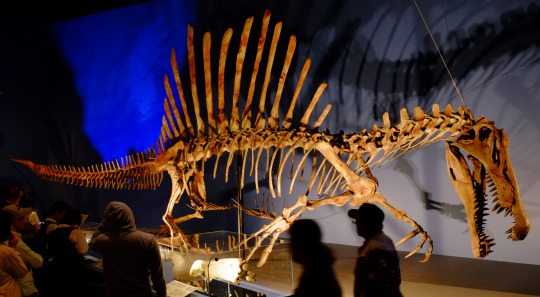
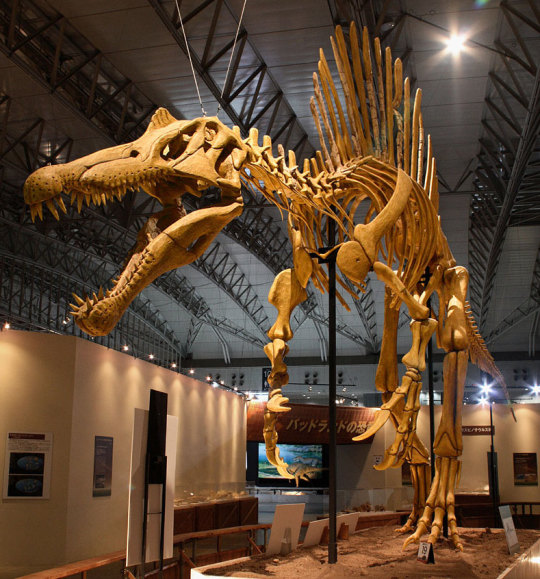
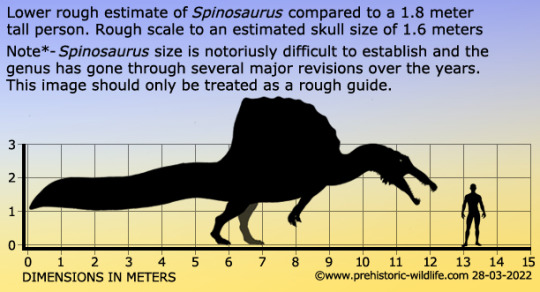
Spinosaurus
(temporal range: 99-93.5 mio. years ago)
[text from the Wikipedia article, see also link above]
Spinosaurus (/ˌspaɪnəˈsɔːrəs/; lit. 'spine lizard') is a genus of spinosaurid dinosaur that lived in what now is North Africa during the Cenomanian to upper Turonian stages of the Late Cretaceous period, about 99 to 93.5 million years ago.[2][3] The genus was known first from Egyptian remains discovered in 1912 and described by German palaeontologist Ernst Stromer in 1915. The original remains were destroyed in World War II, but additional material came to light in the early 21st century. It is unclear whether one or two species are represented in the fossils reported in the scientific literature. The best known species is S. aegyptiacus from Egypt, although a potential second species, S. maroccanus, has been recovered from Morocco. The contemporary spinosaurid genus Sigilmassasaurus has also been synonymized by some authors with S. aegyptiacus, though other researchers propose it to be a distinct taxon. Another possible junior synonym is Oxalaia from the Alcântara Formation in Brazil.
Spinosaurus is the longest known terrestrial carnivore; other large carnivores comparable to Spinosaurus include theropods such as Tyrannosaurus, Giganotosaurus and Carcharodontosaurus. The most recent study suggests that previous body size estimates are overestimated, and that S. aegyptiacus reached 14 metres (46 ft) in length and 7.4 metric tons (8.2 short tons) in body mass.[4] The skull of Spinosaurus was long, low, and narrow, similar to that of a modern crocodilian, and bore straight conical teeth with no serrations. It would have had large, robust forelimbs bearing three-fingered hands, with an enlarged claw on the first digit. The distinctive neural spines of Spinosaurus, which were long extensions of the vertebrae (or backbones), grew to at least 1.65 meters (5.4 ft) long and were likely to have had skin connecting them, forming a sail-like structure, although some authors have suggested that the spines were covered in fat and formed a hump.[5] The hip bones of Spinosaurus were reduced, and the legs were very short in proportion to the body. Its long and narrow tail was deepened by tall, thin neural spines and elongated chevrons, forming a flexible fin or paddle-like structure.
Spinosaurus is known to have eaten fish, and most scientists believe that it hunted both terrestrial and aquatic prey. Evidence suggests that it was semiaquatic; how capable it was of swimming has been strongly contested. Spinosaurus's leg bones had osteosclerosis (high bone density), allowing for better buoyancy control. Multiple functions have been put forward for the dorsal sail, including thermoregulation and display; either to intimidate rivals or attract mates. It lived in a humid environment of tidal flats and mangrove forests alongside many other dinosaurs, as well as fish, crocodylomorphs, lizards, turtles, pterosaurs, and plesiosaurs.
9 notes
·
View notes
Text
Monster Hunter concepts Pt. 2: The Raptors II
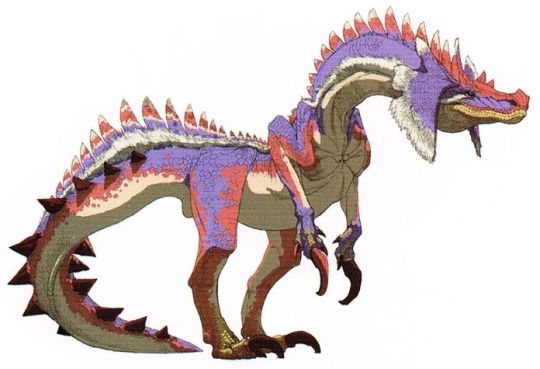
After covering the raptor monsters from earlier gens it's time for those introduced from Monster Hunter Tri onwards. That brings us to the Jaggis and co.
The young males are known as Jaggi, the adult females Jaggia, and the alpha is known as Great Jaggi. This updated naming convention, using "Great" instead of the "-drome" suffix is not the only significant change in early bosses. It is clear that these small pink dinosaurs are an improvement over the Preys of previous generations, with a less rigid posture that feels bird-like and natural. Their pink and lilac colouration is also an interesting choice and somehow doesn't feel so out of place, and the frills on the sides of their head are a nice alternative to a crest. The Great Jaggi also improves the evolution of an leader design, as unlike Velocidrome, it isn't just a larger Velociprey with a larger crest: its body is way more robust and heavy, it has large hooked claws and bigger spikes on its tail, as well as a more prominent frill and a white mane running through it's neck and tail. It feels more menacing, or at least, menacing enough for a first boss fight. Can you hear it? AUGH AUGH AUGH. This monster is beloved by fans (despite being a punching bag) and it is definitely deserved, hopefully it will come back in future games.
Then we have Baggi and Great Baggi from the freezing Tundra (and also the Frost Islands), blue-yellow relatives of the Jaggi with a forward facing crest, their design might not be as elaborate, but the different limb shape and patches of fur are nice little changes that make them feel different enough. The Great Baggi doesn't fail to appear as a stronger boss either, thanks to its piercing yellow eyes, large crest and thicker limbs. The sleeping spit of these blue beasts also offers an additional level of difficulty.
Lastly for 3rd gen we have Wroggi and Great Wroggi, these are the most odd-looking of the bunch. Like Ioprey and Iodrome, their design has more amphibian traits, with a shiny orange skin and inflatable throat sacs. Wroggis sport two blue sacs on the sides, while Great Wroggi has a single, large purple sac as display structure. They are also poisonous, but unlike Iopreys, they emit this poison in a cloud that stays for a bit, making the fight against Great Wroggi a bit more interesting, breaking the throat sac of Great Wroggi also reduces its spitting ability, adding a tactical advantage to the break. Other elements on their design, including their narrow snout and multiple flaps on the forelegs and tail, kind of give it a feel of being semiaquatic despite being terrestrial.
While I wanted to talk about the etymology of the 3rd gen raptors, the truth is that it isn't really known. Theories include that Jaggi comes from "jagged" (due to their jagged tails), baggi comes from, well, "baggy" (referencing its sleep-inducing ability) and Wroggi (Furogi in Japanese) seems to come from "froggy" (ribbit ribbit). But honestly, it possibly is something less obvious.
In 4th gen we didn't get a new raptor until MH Generations with the Maccao and Great Maccao, these jumpy fellows have a pretty fancy design based on tropical birds: a yellow crest, vibrant red skin and green feathers on the body. They are also feisty and use their spiked tails and scuted limbs to hit you. The Great Maccao also uses a variety of movements including kicks and punches, something that previous raptors didn't really do, this makes its fight incredibly fresh and fun (if only it didn't last less than 5 minutes). The theme of this monster is clearly based on martial arts, and the name Maccao reflects this: while you may think it comes from "macaw", you couldn't be more wrong, as it is actually a combination of the taiwanese words Màt (punch) y Káo (knee).
Lastly we have the Izuchi and Great Izuchi that were introduced relatively recently in Monster Hunter Rise. Following the theme in the game around the yokai, it is quite obvious that this monster is based on the Kamaitachi, a weasel-like yokai with sickle-like limbs that travels in whirlwinds and leaves small cuts on people before they notice. Its chestnut fur is clearly based on a weasel, while the sickle tail on Great Izuchi is its predominant trait and main weapon. The most innovative gimmick of its fight, however, is that it always travels with two Izuchis and combines attacks with them. This raptor fight is by far the one that feels the most like a team fight. Lastly, to mention its etymology, unlike other "dromes" and "greats", the Japanese name for the Great Itachi isn't Dosuizuchi, but Osaizuchi, this is a combination of 長 osa (leader), 飯綱 izuna (weasel) y 窮奇 kamaitachi. Pretty cool right?
12 notes
·
View notes
Note
shitty summary of your blog:
You go feral over fucked up animal facts, are down bad for tfp megsy and also your my best friend I adore you thank you for making my day better <3
First of all, honestly thanks thanks thanks thanks thanks
Second of all, yes I exactly blame the Paxil for why I simp for him, that shit flicked a switch
Last of all: you have prompted me to share more fucked up animal facts:
There is a dinosaur that was first described in 2011 that only has one claw on its short arms, Linhenykus. I just think y'all need to look at the fucked up little guy, every reconstruction I've seen of it has been adorable.
You might already know that axolotls can pretty much grow anything back, but I doubt you know about firefly axolotls: they're made when someone cuts the tails off of two axey larvae and swaps them, and somehow they take and that's just. Their tail now. IICR though this is generally considered unethical
Nothing stops you from grabbing a pigeon to have as a pet as they are feral animals not wild ones. You might get pecked however.
Did you know that the reason you see more two headed reptiles rather than other animals is because they're more likely to survive? I watched way too much "Weird True and Freaky" as a kid and there's an example in the intro
Look up what a worm ball is
Just look at the absolute pissing match in the paleontology community surrounding Spinosaurus at all times. 100% why it's my favorite dinosaur, it is consistently embroiled in debate. There's constantly a new paper coming out saying "oh but it isn't really aquatic" "but yes yes it is aquatic" bae it's semiaquatic, we found a fucking tail fluke.
Legit anything about Irritator challengeri. From how we found the skull that was all kinds of fucked up, to the newest paper about it possibly having a jaw like a pelican.
Honestly shit gets wild in the paleo community
Like, anyone else know about the Tyrannosaurus regina and Tyrannosaurus imperator paper? The one the majority of the community took one look at and said "yeah... No." oh honestly checking Wikipedia to fact check things I'm reminded of the Nanotyrannus debate. It's sad because Imperator is a fucking dope name.
Snakes don't actually unhinge their jaws! It's worse than that! You see, their lower jaws aren't joined like ours are, meaning they can basically open sideways and "walk" them in order to get the food down. Honestly just take a look at a snake skull and you'll figure out how secretly weird they are
There's a gene responsible for limb development, the sonic hedgehog gene, which if it's turned off the animal won't develop legs and will end up with just a long body— and we think that mutations fucking with that gene is how we got snakes.
... but while we know how snakes lost their legs, we still aren't entirely sure why. There's the "digging" camp and a "swimming" camp, and I'm gonna stay neutral until we get more evidence. What we do know iicr is that the first snakes were likely venomous!
There are snakes who are poisonous but not venomous, such as the Rhabdophis keelback snakes. They get it from toads, but are generally considered to be harmless. These fuckers are adorable, just look at them

Look at that face, so pretty.
#this got long#ask game#.... kinda#fun facts#always take anything i say with a grain of salt and do your own research
8 notes
·
View notes
Text
my brain involentarily made a connection today that's absolutely silly and should not be taken seriously but...
Coming up with ways to draw characters who aren't human, like cookie run characters for example, reminds me a bit of like, dinosaur reconstruction design things.
is this cloth? is this part of it's body? is this the ACTUAL color of this? is this practical? is this how an actual living creature would look? what kind of lifestyle and environment does this creature live in and how would that influence their clothing choices-
like you know, similar vibes.
absolutely silly? yes. but as someone who likes drawing dinosaurs to some degree, and cookies, and when i do draw dinosaurs i try to do so with a somewhat scientific approach at least (okay i mostly draw microraptors because they're the best thing from the time period but i digress) it's easy to make that kind of association. now im thinking of those old dinotopia books... to go along with this post i've drawn a rough sketch of a microraptor (from memory i diddint try that hard to actually get it right this time-) on espresso's lap in one of my favortie drawings of espresso.
I feel like if he had a dinosaur he'd have something clever and helpful, im not sure if a microraptor would be helpful , but he'd probably encounter one anyways because I can absolutely see Madeline just befriending an entire flock of them, they've both got too many winglike features going on, why not.

so yeah have my incredibly quick rough sketch of a memory microraptor, if you think it's bad or want to scold me, go draw a spinosaurus without reference and then go cry because you cant draw an accurate spinosaurus because next week another persons just going to come out and say it flew in the air or lived a subterannian lifestyle and the entire community will lose it again because spinosaurus is the dinosaur equivalent of the platypus.
please im begging you if you're going to have a fight about spinosaurus in the comments...be funny about it.
6 notes
·
View notes
Text
Spectember D27: Revamp the Dinosauroid

The end of the Triassic propitiated finally the dominance of dinosaurs in the next period with the rupture of the large supercontinent Pangea, though in this timeline something pushed further the fragmentation of the continent, and instead of just opening the rift of the Atlantic, it multiplied across Africa and a section of south America, making the Tr/J mass extinction more severe and killing out many more species of dinosaurs, so now the Jurassic was no longer dominated by the animals we have in our timeline, instead we get a strange variety of large dinosaur-like crocodiles, many sauropodomorphs that diverged from the smaller species that survived and never went into the same trend of gigantism as in our earth, many synapsids and so on.
At the end of the late Jurassic a lot happened with the new order, within some of the second radiation of sauropodomorphs included varied carnivorous carnosaur-like species, medium size coelurosaur-like omnivores and smaller herbivores that look like silesaurs; from the omnivore lineage that have expanded in varied niches would rise a branch of semiaquatic species that resembled something like a scaly penguin with hands, long finger and claws, with short robust tails, shorter necks and longer heads with narrow keratinized mouths.
They are remarkable as many other animals of this world, through one particular species seems to have started a peculiar evolutionary trend in the last 10 million years.
For the reader, we will refer to this species as the Shagoids, a species originated from 50 cm long aquatic sauropodomorph descendants that wandered on the estuaries of the now more fragmented north Africa/south American region, their ancestors were more of a mix of a cormorant with an otter as unlike the rest of its own family this belongs, as one main feature of these are they still functional forelimbs, these still preserved functional arms and hands that helped them to manipulate their prey of crustaceans and mollusks. Over time these developed strategies to break down their prey shell, including the habit of picking and using stones which choose appropriately for this task. This behavior was passed on to new generations, learned and properly helped them to get food with less effort, the food quality increased brain energy, brain size also increased and so their skills were forged much more adequately.
It was on matter of few million years the Shagoids lineage abandoned their swimming lifestyle and became mostly semi aquatic coastal dwellers, living in the shores and just entering water to hunt their food rather than spending most of their time there. As social animals they formed hierarchy groups, formed by the head of a dominant female around minor males that could either mate with her or just serve them, as well many other younger individuals, matriarchs often had the duty to select and organize hunting and spending of food, as well regulate reproduction and mating between their lower family, as she normally is the eldest of the group, and only another female of the same blood can turn into a elder matriarch of if mated by the son of the elder, this perhaps was the moment they gained proper sentience as how they defined a cultural and social structure.
It seems at the end rathe in a sudden change of sea level in the last 3 million years did the final push on their evolutionary journey, as most of the Shagoid populations got stranded within the main continent with almost no way to find new connections to large water bodies, in other situation their species would have die for starvation, but at that point they were already adapted to feed on other food sources, from tubers, insects and small animals, being able to cook them using fire they managed to craft, and so properly passed the harsh time with the loss of a chunk of their population over the sudden change.
When the Shagoid expanded and found again large water bodies far from their native regions, they really have changed considerable from their ancestors, as their closest relative was a sort of strange loon like reptilian species wandering in the coasts, these were more like limbed penguins with long arms and tridactyl hands, which the third finger being a derivation of the 4th an 5th clawless digit fused into one, their short legs lost their webbed feet a while ago and are more adapted for walking, their head still preserve the characteristic seabird like shape but their teeth have changed in shape to be generalistic omnivore, with a large head which houses the most intelligent brain in the planet.
Over the last thousands of years, they have been becoming more and more prone to establish permanent settlements populated by hundreds of them much more different of their wandering tribes, often farm plants and even carry some animals for domestication.
For the first time in their history they are in the pathway of civilization… who knows what will happen next, either the Shagoid can remain like this until their extinction, or they will start building towards the sky and beyond.
#speculative evolution#alternative evolution#triassic#jurassic#sauropodomorph#dinosauroid#sapient#spectember
36 notes
·
View notes